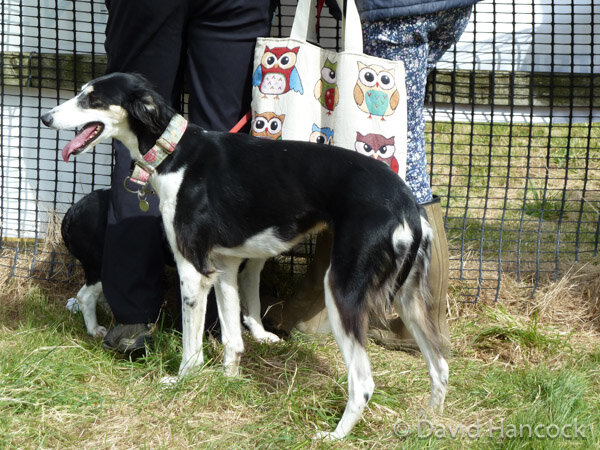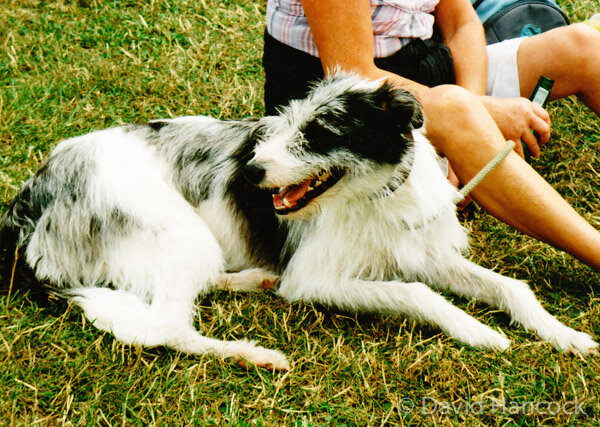1243
INGREDIENTS FOR A LURCHER
By David Hancock
What actually is a lurcher? asked my visitor from London, as we walked round a local country show. If you look around at a lurcher show, it is soon apparent that the event could be accurately labelled "any variety, sporting dog", for the height, weight, coat and colour is essentially anything but uniform. For a lurcher must be a cross-bred dog, fast enough to catch a hare, crafty enough not to get caught doing so, silent at all times and able to endure the cold and the wet. Old-timers would say it really must be a working sheepdog cross Greyhound to be a true lurcher, but Deerhound, Whippet, Saluki, Bedlington Terrier and Staffordshire Bull Terrier blood have all been used down the years to provide a more protective coat, greater stamina or enhanced determination in the chase. My visitor from London was amazed at the range of types.
The word lurcher does give many dog-show fanciers the impression of a coarsely-bred dog, with no regard to handsomeness, just a mongrel sighthound of questionable merit. But the majority of lurchers that I see at country shows have been skilfully bred by knowledgeable dog-men, men with decades of experience with hunting dogs. They can be superb canine athletes, built for function and devastating in the field. The sheer muscularity of Bull-lurchers (those with plenty of Bull Terrier in the blend), the awesome stature of the Deerhound hybrids and the deceptive power of the Whippet crosses is impressive. Lurcher breeders are seeking performance not appearance yet still manage to breed some strikingly handsome dogs. The huge difference between show breeders and lurcher breeders lies in the priority given to appearance and capability. That is not say, of course, that there are not some highly effective pure-bred coursing Deerhounds, racing Afghans and Whippets, and lure-chasing Salukis.
It is often easy, at a lurcher show, to see the components of the blend of breeds manifesting themselves. The Ridgeback cross is soon revealed by the fiddle down the spine; the Deerhound blood by the shaggy coat; the Bull Terrier infusion by the more muscular build. The Whippet-Greyhound cross is often the most popular. Lord Orford once crossed his Greyhounds with Bulldogs to instil more gameness; that is unlikely to be repeated with today's Bulldog!
The esteemed ‘Stonehenge’ once referred to lurchers with these words: "A poacher possessing such an animal seldom keeps him long, every keeper being on the look-out, and putting a charge into him on the first opportunity; and as these must occur of necessity, the poacher does not often attempt to rear the dog which would suit him best, but contents himself with one which will not so much attract the notice of those who watch him". Strictly speaking, on this evidence, a judge at a lurcher show should automatically disqualify any dog which would appear to a gamekeeper to be a coursing dog! That would thin out the class sizes in no small way! 'Stonehenge' has managed however to convey the essential ordinariness, the vital anonymity and the lack of type if a lurcher is to survive. Variety was not just the spice of life, it almost assured a life!
This variation in type manifests itself at lurcher shows today, with classes for rough and smooth-haired dogs and those under or over 23 inches at the withers. Some breeders swear by the Saluki cross and others by Bedlington blood; some fanciers favour a rough or harsh-haired dog and others the smooth variety. A minority prize the 'Smithfield' blood from the old drovers' dogs and there are often more bizarre crosses such as Kelpie cross Whippet, Labrit cross Whippet or more often Whippet cross Greyhound. The concept, as always with a hunting dog, is to find the ideal match between quarry, country and conditions on one hand and speed, determination and hunting instinct on the other.
The qualities or assets that lurcher breeders are seeking embrace speed and prey-drive from the sighthound, sagacity from the Collie, a protective coat from the Deerhound or Bedlington and terrier spirit from the Staffie or Airedale. Getting the blend right and the sources appropriate both for ground and quarry is the skill. Casually crossing your Whippet with the nearest Beardie should produce a lurcher in appearance but not necessarily in performance. The gypsies’ dogs from near my boyhood home would catch their quarry in the night, come home for a quick rest before being sent out again to retrieve their ‘bag’ from where it had been deposited - in a hedgerow, under bracken or in some other hiding place. The local gamekeeper never once caught one of these gypsies red-handed. Their lurchers looked very ordinary but certainly performed! But a dog bred entirely for performance is always going to have the most appeal for me. My visitor from London readily agreed that human athletes don’t always resemble matinee idols!











